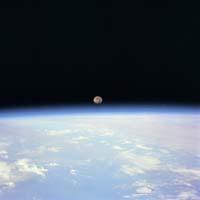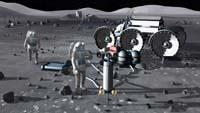To the Moon by the subway
2007/03/11 Galarraga Aiestaran, Ana - Elhuyar Zientzia

For space agencies in various countries, the Moon is now their main goal. (Photo: Recent searches
The combination of both unit systems can have tragic consequences. This became clear, for example, when the climate orbiter of Mars was lost. Apparently, the error was due to the mixture of measures: the contractor who gave information for the activation of the propulsor used the Anglo-Saxon system of the units, while NASA worked in the metric system.
With the decision adopted by NASA, the risk of such errors disappears, at least in missions related to the Moon. Other positive consequences. For example, it will facilitate collaboration with other space agencies that target the moon.
Multi-system

In grey areas the metric system is used, while in red areas Anglo-Saxon units of measurement are used. The Moon appears at scale. (Photo: NASA)
Anglo-Saxon units of measurement are not widely used in science, but are used only in the United States, Liberia and Myanmar. In all other places the metric system is used and now also on the Moon. Therefore, some say that the metric system has achieved a great victory with this decision, since it has increased its field in the solar system by 27%.
The decision came from NASA meetings with thirteen other space agencies. The aim of these meetings was to create ways of coordination and collaboration between space agencies in missions to the Moon. The introduction of the metric system in the United States was one of the initial discussion topics.
Thus, those responsible for these thirteen space agencies, ESA and space agencies in Australia, Canada, China, Germany, Britain, France, India, Italy, Japan, Russia, South Korea and Ukraine enthusiastically applauded the decision to reject the Anglo-Saxon unit of measurement.

The common use of the same units of measurement will facilitate collaboration. (Photo: NASA)
Thus, those responsible for these thirteen space agencies, ESA and space agencies in Australia, Canada, China, Germany, Britain, France, India, Italy, Japan, Russia, South Korea and Ukraine enthusiastically applauded the decision to reject the Anglo-Saxon unit of measurement.
Although there is some competition between these countries over missions to the Moon, their intention is to act in a certain way together and, undoubtedly, the use of the same units of measure will facilitate collaboration. For example, if you want to place a permanent base, the contributions of the different agencies will be compatible and there will be no problems to replace the parts.
Published in 7K.

Gai honi buruzko eduki gehiago
Elhuyarrek garatutako teknologia




